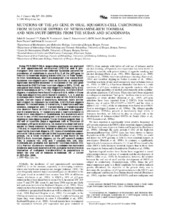Mutations of the p53 gene in oral squamous-cell carcinomas from sudanese dippers of nitrosamine-rich toombak and non-snuff-dippers from the Sudan and Scandinavia
Ibrahim, Salah Osman; Vasstrand, Endre N.; Johannessen, Anne Christine; Idris, Ali M.; Magnusson, Bengt; Nilsen, Rune; Lillehaug, Johan
Journal article
Permanent lenke
https://hdl.handle.net/1956/2152Utgivelsesdato
1999-11-08Metadata
Vis full innførselSamlinger
Sammendrag
Using PCR-SSCP/DNA sequencing methods, we analyzed 14 oral squamous-cell carcinomas (OSCCs) and 8 pre-malignant oral lesions from different Sudanese patients for prevalence of mutations in exons 5 to 9 of the p53 gene in relation to toombak-dipping status. OSCCs (14 from Sudan, 28 from Scandinavia), and 3 pre-malignant oral lesions from Sudanese non-dippers were used as controls. A statistically significant increased incidence in mutations of the p53 gene was found in OSCCs from toombak dippers (93%; 13/14), as compared with those from non-dippers in Sudan (57%; 8/14) and in Scandinavia (61%; 17/28) respectively. In OSCCs from dippers, mutations were found in exons 5 to 9, while in those from non-dippers they were found in exons 5, 7, 8, 9, and no mutations were found in exon 8 in any of the OSCCs from Sudan. Certain types of mutations, however, were similar with respect to exposure to toombak. OSCCs from dippers showed 15 transversions, 9 transitions, 3 insertions and one deletion, compared with 7 transversions, 2 transitions and one deletion found in OSCCs from Sudanese non-dippers, and 9 transversions, 17 transitions and 2 insertions found in those from non-dippers in Scandinavia. No mutations were found in any of the non-malignant oral lesions in relation to dipping or non-dipping status. These findings suggest that (i) the use of toombak plays a significant role in induction of increased p53 gene mutations, (ii) mutations observed were similar to those induced by tobacco-specific N-nitrosamines (TSNAs) in experimental animal models and those already reported in toombak dippers, (iii) types of mutations associated with TSNAs were similar in the exposed and the control groups, (iv) a novel mutation in exon 6 was found in the OSCCs from toombak dippers, (v) the p53 exons 5 (codon 130), 6 (codons 190, 216) and 7 (codons 229, 249, 252) mutations are probable hot spots for toombak-related OSCCs. Further studies are necessary to validate the increased incidence and exon locations of the p53-gene mutations as a biomarker of malignant transformation in populations in which the oral use of tobacco is habitual.
